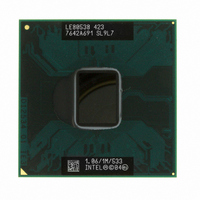LE80538VE0041M Intel, LE80538VE0041M Datasheet - Page 59

LE80538VE0041M
Manufacturer Part Number
LE80538VE0041M
Description
IC PROC CELERON M 1.06GHZ 479BGA
Manufacturer
Intel
Datasheet
1.LE80535NC013512.pdf
(69 pages)
Specifications of LE80538VE0041M
Processor Type
Celeron M
Features
533MHZ Bus, 1M L2 Cache
Speed
1.06GHz
Voltage
0.94V
Mounting Type
Surface Mount
Package / Case
479-BGA
Lead Free Status / RoHS Status
Lead free / RoHS Compliant
Other names
883549
Available stocks
Company
Part Number
Manufacturer
Quantity
Price
Intel
®
Table 25. Signal Description (Sheet 4 of 7)
Celeron
®
M Processor Datasheet
HIT#
HITM#
IERR#
IGNNE#
INIT#
ITP_CLK[1:0]
LINT[1:0]
LOCK#
Name
Input/
Output
Input/
Output
Output
Input
Input
Input
Input
Input/
Output
Type
HIT# (Snoop Hit) and HITM# (Hit Modified) convey transaction snoop operation
results. Either FSB agent may assert both HIT# and HITM# together to indicate
that it requires a snoop stall, which can be continued by reasserting HIT# and
HITM# together.
IERR# (Internal Error) is asserted by a processor as the result of an internal
error. Assertion of IERR# is usually accompanied by a SHUTDOWN transaction
on the FSB. This transaction may optionally be converted to an external error
signal (e.g., NMI) by system core logic. The processor will keep IERR# asserted
until the assertion of RESET#, BINIT#, or INIT#.
For termination requirements please refer to the platform design guides.
IGNNE# (Ignore Numeric Error) is asserted to force the processor to ignore a
numeric error and continue to execute noncontrol floating-point instructions. If
IGNNE# is deasserted, the processor generates an exception on a noncontrol
floating-point instruction if a previous floating-point instruction caused an error.
IGNNE# has no effect when the NE bit in control register 0 (CR0) is set.
IGNNE# is an asynchronous signal. However, to ensure recognition of this signal
following an Input/Output write instruction, it must be valid along with the TRDY#
assertion of the corresponding Input/Output Write bus transaction.
INIT# (Initialization), when asserted, resets integer registers inside the processor
without affecting its internal caches or floating-point registers. The processor
then begins execution at the power-on Reset vector configured during power-on
configuration. The processor continues to handle snoop requests during INIT#
assertion. INIT# is an asynchronous signal. However, to ensure recognition of
this signal following an Input/Output Write instruction, it must be valid along with
the TRDY# assertion of the corresponding Input/Output Write bus transaction.
INIT# must connect the appropriate pins of both FSB agents.
If INIT# is sampled active on the active to inactive transition of RESET#, then the
processor executes its Built-in Self-Test (BIST).
For termination requirements please refer to the platform design guides.
ITP_CLK[1:0] are copies of BCLK that are used only in processor systems
where no debug port is implemented on the system board. ITP_CLK[1:0] are
used as BCLK[1:0] references for a debug port implemented on an interposer. If
a debug port is implemented in the system, ITP_CLK[1:0] are no connects.
These are not processor signals.
LINT[1:0] (Local APIC Interrupt) must connect the appropriate pins of all APIC
Bus agents. When the APIC is disabled, the LINT0 signal becomes INTR, a
maskable interrupt request signal, and LINT1 becomes NMI, a nonmaskable
interrupt. INTR and NMI are backward compatible with the signals of those
names on the Pentium
Both of these signals must be software configured via BIOS programming of the
APIC register space to be used either as NMI/INTR or LINT[1:0]. Because the
APIC is enabled by default after Reset, operation of these pins as LINT[1:0] is
the default configuration.
LOCK# indicates to the system that a transaction must occur atomically. This
signal must connect the appropriate pins of both FSB agents. For a locked
sequence of transactions, LOCK# is asserted from the beginning of the first
transaction to the end of the last transaction.
When the priority agent asserts BPRI# to arbitrate for ownership of the FSB, it
will wait until it observes LOCK# deasserted. This enables symmetric agents to
retain ownership of the FSB throughout the bus locked operation and ensure the
atomicity of lock.
®
processor. Both signals are asynchronous.
Description
59












